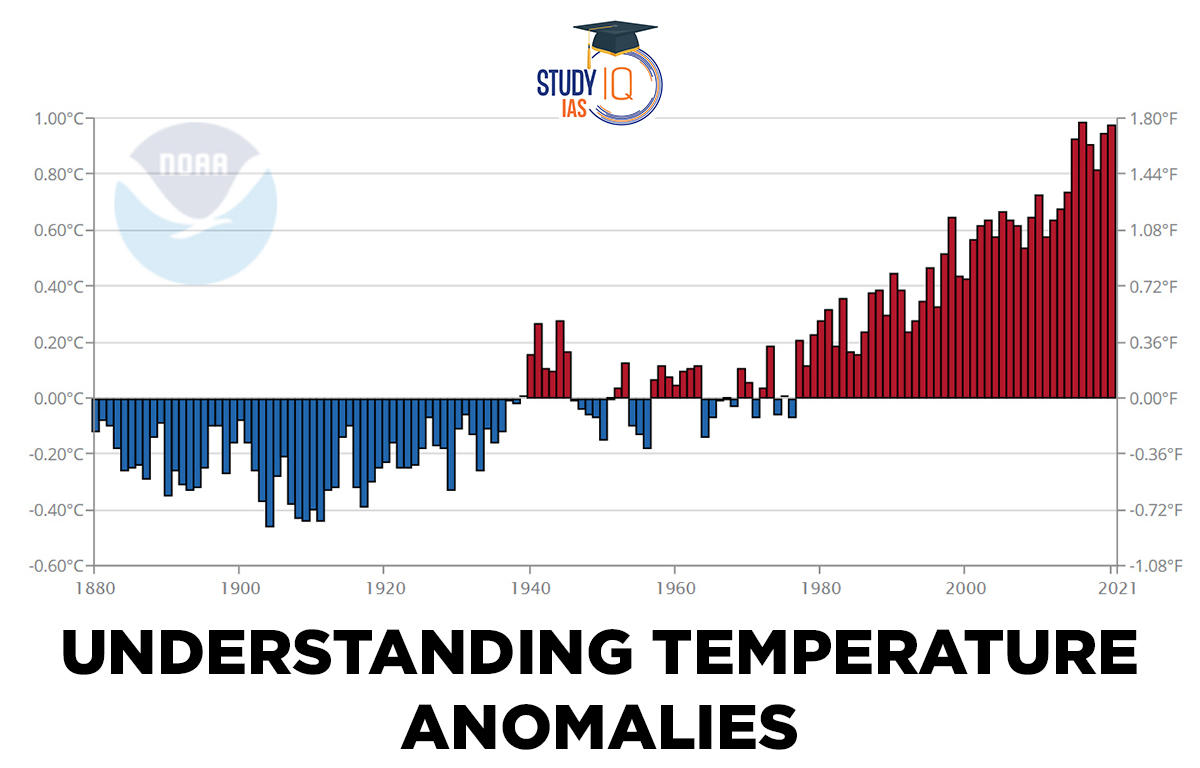Table of Contents
Context: Recent reports have highlighted that March 2023 was the second warmest March on record.
Temperature Anomaly
- Temperature anomaly represents a departure from a reference value or long-term average, which is normally chosen as an average of temperatures over a certain reference period.
- What are the causes of Temperature anomaly?
- Greenhouse gas emissions: The emissions of greenhouse gases such as Carbon dioxide, Methane etc have increased rapidly, affecting the Earth’s heat budget. This has a major impact on global temperatures.
- Decline in albedo: Albedo is the reflective capability of a surface. The albedo of the earth, which was higher due to presence of polar ice caps, has declined significantly. As reflective capacity declines, more heat is absorbed.
- Solar activity: Solar activity also plays a role in Earth’s temperature profile. Even though it has no major role in global warming, it can influence Earth’s climate.
- Natural factors: Natural events such as volcanic eruptions release large quantities of aerosols in the atmosphere, which has an effect on cooling of the planet.
Temperature Anomalies in March
- While March 2023 was the second warmest March on record, March 2016 was the warmest of March. This event was triggered by a ‘mini’ global warming because of the biggest El Niño of the 21st century.
- During an ‘El Niño year’, warmer water spreads in a band from west to east over the equatorial Pacific Ocean. In a ‘La Niña year’, cooler water spreads east to west in the same region.
- Both these phenomena create distinct and significant effects on the global climate.
- March in India marks the beginning of summer season. Some March may be cooler due to other climate factors, such as a La Niña.
- Causes:
- Increase in heat zones: Since maximum heating zone runs along central India regions between Odisha and Gujarat, temperatures start soaring in March.
- Decline in pre-monsoon showers: The lack of pre-monsoon showers has contributed to the overall heating. Rainfall due to western disturbances has not been below normal.
Impact of warmer March on India
- Temperature variations: Weather anomaly, due to warming to the west to north of India led to cooler March over Mumbai, excess pre-monsoon rains over the northwest and scorching heatwaves in Kerala and Odisha.
- Weaker western disturbances: Due to warmer temperatures, the effects of western disturbances was subdued. This deprives northern parts of India from much needed winter rainfall.
- Prolonged heatwaves: Rapid warming of Middle-East and northern Arabian Sea has enhanced the duration, frequency, and intensity of heat waves over India in the pre-monsoon season.
- Stronger monsoon and cyclogenesis: A warmer Arabian Sea as a result of weather anomaly can favour a stronger monsoon but may also enhance cyclonic circulation over the Arabian Sea.
- Stronger monsoons have the potential to produce heavy rainfall events over northwest India and Pakistan.
- Weaker El Niño: Warmer March has reduced snowfall over the Eurasian landmass, which tends to favour a stronger monsoon.
- Even though 2023 is expected to be an El Niño year (which tends to produce weaker monsoons), its effect could be blunted by the lower snow cover over Eurasia.
- Crop damage: Rabi crops require cooler temperatures for optimal output. Weather anomaly in form of warmer temperatures may lead to crop damage, affecting food security.
Way Forward
- Global warming does not mean each month or each year will be warmer than the previous month/year. Instead it is a long term phenomenon that is more visible over decades.
- Climate scientists will have to provide context while comparing temperature data so that people at large understand global warming better as well as its cascading effects on the weather.
- Effects of global warming locally can be a better way of conveying people about its effects rather than on a global scale. This will motivate them on climate action.
El Niño vs La Niña
El Niño–Southern Oscillation(ENSO)
- ENSO is an irregular periodic variation in winds and sea surface temperatures over the tropical eastern Pacific Ocean, affecting the climate of much of the tropics and subtropics.
- The warming phase of the sea temperature is known as El Niño and the cooling phase as La Niña.
| Comparison | El Niño | La Niña |
| Meaning | El Niño means Little Boy, or Christ Child in Spanish. | La Niña means Little Girl in Spanish. |
| Sea surface temperature | It represents the periodic warming of sea-surface temperatures across the east-central equatorial Pacific. | It represents the periodic cooling of sea-surface temperatures across the east-central equatorial Pacific. |
| Pressure | It is laden with high air surface pressure in the western Pacific. | It contain low air surface pressure in the eastern Pacific |
| Formation | During El Niño, trade winds weaken. Warm water is pushed back east, toward the west coast of the Americas, resulting in a weaker Walker cell. | During La Niña , trade winds are even stronger than usual, pushing more warm water toward Asia, resulting in a stronger Walker cell. |
| Period of occurence | Typically occure every 3-5 years and lasts 9-12 months. | Typically occur every 3-5 years and lasts 1-3 years. |
| Impacts | Droughts in eastern Australia
Flooding in western South America Weak upwelling over the west coast of South America. |
Excessive rainfall in the eastern Australia
Drought conditions prevail in the South America Strong upwelling over the west coast of South America. |
| Impact on Indian Monsoon | The monsoon is affected so heavily that 70% reduction of the rainfall is expected. The winds doesn’t carry the moisture towards Indian landmass dueing El Nino causing deficiency in rainfall. | La Nina causes high temperatures over the Indian Ocean, off the Somalian coast and a comparatively better monsoon rains in India. |


 Current Affairs 29th April 2024 for UPSC...
Current Affairs 29th April 2024 for UPSC...
 Towards Green Growth, Impact of Climate ...
Towards Green Growth, Impact of Climate ...
 Editorial of the day (29th Apr): Israel ...
Editorial of the day (29th Apr): Israel ...

















